Eggplant with Minced Pork (Mābō Eggplant) is a twist on my recipe, Mābōdōfu (Mapo Tofu). The fried eggplant wedges replace the tofu cubes, giving a richer flavour to the dish and a completely different texture to that of Mābōdōfu. The beautiful deep purple of the eggplant skin stimulates your appetite.
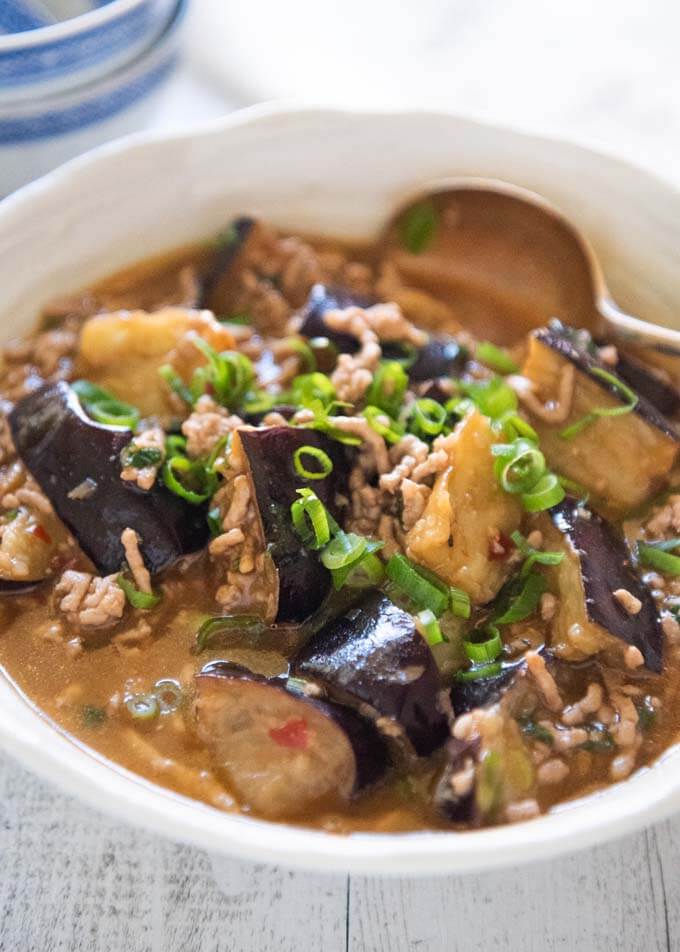
Although the flavour was modified slightly to suit to the Japanese palate, Mābōdōfu (Mapo Tofu) is a recipe from China. However, Mābō Eggplant is a Japanese invention and it is called ‘mābō nasu‘ (麻婆茄子) in Japanese. The word ‘tofu‘ (豆腐) in Mābōdōfu (麻婆豆腐) is replaced by ‘nasu‘ (茄子) which is eggplant.
Eggplant and pork mince (ground pork) are a good match. Miso and eggplant are also a good combination. It’s absolutely natural that simply replacing tofu with eggplant results in a tasty dish. Mābō Eggplant is an easy and flavoursome eggplant recipe.
What is in Eggplant with Minced Pork
The list of ingredients is very similar to Mābōdōfu. There are many seasonings used here but, like any other stir-fried dishes, once you get all the ingredients measured and ready, it is quite quick to make.
Other than the seasonings, the key ingredients are just pork mince and eggplants. I used a large eggplant and cut it into the bite-size wedges. You can of course use skinny/small eggplants instead.
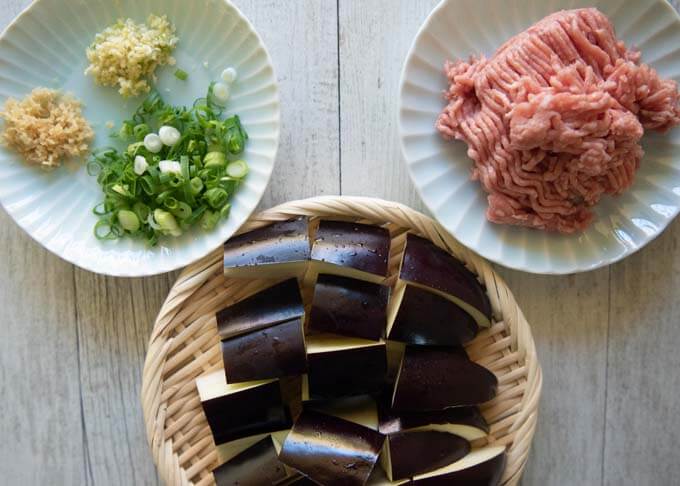
Other ingredients needed to make Eggplant with Minced Pork (Mābō Eggplant) are split into two groups. The first group below is to season the pork mince while stir-frying and make chilli pork mince:
- Finely minced garlic
- Finely minced ginger
- Finley chopped shallots/scallions
- Salt
- Chilli bean paste called ‘toban-djan’ (豆板醤)
The second group below is a thick sauce for the dish:
- Water
- Soy sauce
- Sugar
- Chicken stock powder
- Cooking sake
- Brown miso
- Cornflour/corn starch
How to make Eggplant with Minced Pork
The major difference between the process of making Mābō Eggplant and Mābōdōfu is that the eggplant pieces need to be shallow-fried before mixing them with the mince/ground meat. This is necessary because it is very quick to stir-fry the mince and eggplants are not cooked so fast.
- Coat the eggplant wedges with cornflour/corn starch.
- Shallow-fry the eggplants until the eggplant pieces become soft inside. The depth of the oil is about 1cm / ⅜”.
- Stir-fry the mince, then add the flavouring ingredients to make chilli pork mince.
- Add the sauce ingredients, then the eggplants.
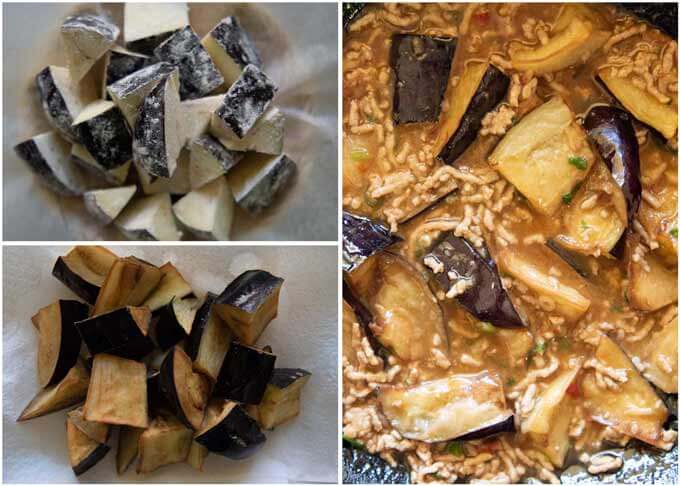
Coating eggplants with cornflour/corn starch before frying makes the fried eggplants moist and soft inside. This is because cornflour/corn starch does not let the moisture out of the ingredients.
Compared to Mābōdōfu, there are extra steps to fry eggplants. But it only takes less than 5 minutes to fry them.
You can freeze it!
Mābōdōfu is not suitable for freezing. Tofu becomes spongy when frozen and loses the original soft texture of Mābōdōfu. But you can freeze Eggplant with Minced Pork (Mābō Eggplant).
The best way is to freeze the meat sauce and fried eggplants separately. Adding the fried eggplants to the meat sauce is the last step in the recipe instructions anyway. So, you stop there before adding the eggplant pieces to the sauce and freeze the eggplants and the sauce in separate containers/freezer bags.
Then, thaw the meat sauce and eggplants in the microwave. If you want the eggplants to be crisper before mixing them into the meat sauce, fry them again.
Mābō Eggplant can keep a day or two in the fridge as well. But the colour of the eggplant skin may become less vibrant.
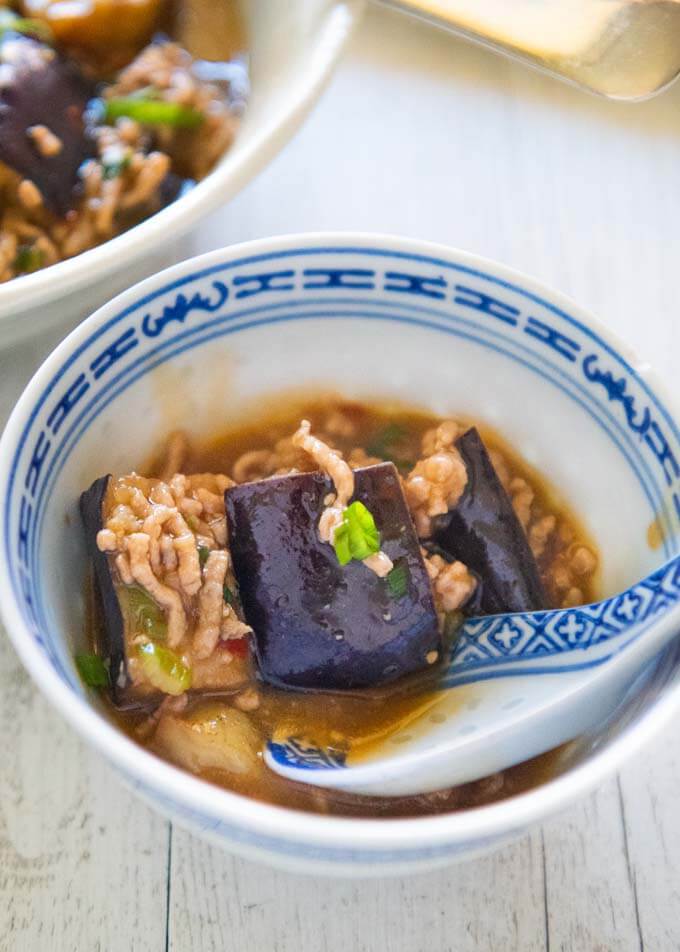
I recently learnt that there are a notable number of people who don’t enjoy tofu dishes. I was quite surprised about that because I think tofu is a healthy ingredient and one food that is delicious with minimal cooking.
Mābō Eggplant is the perfect dish for those people who are not fond of tofu but want to experience the great flavour of Mābōdōfu. But if you like tofu, you will find that both my Mābōdōfu below and today’s Mābō Eggplant are equally delicious!
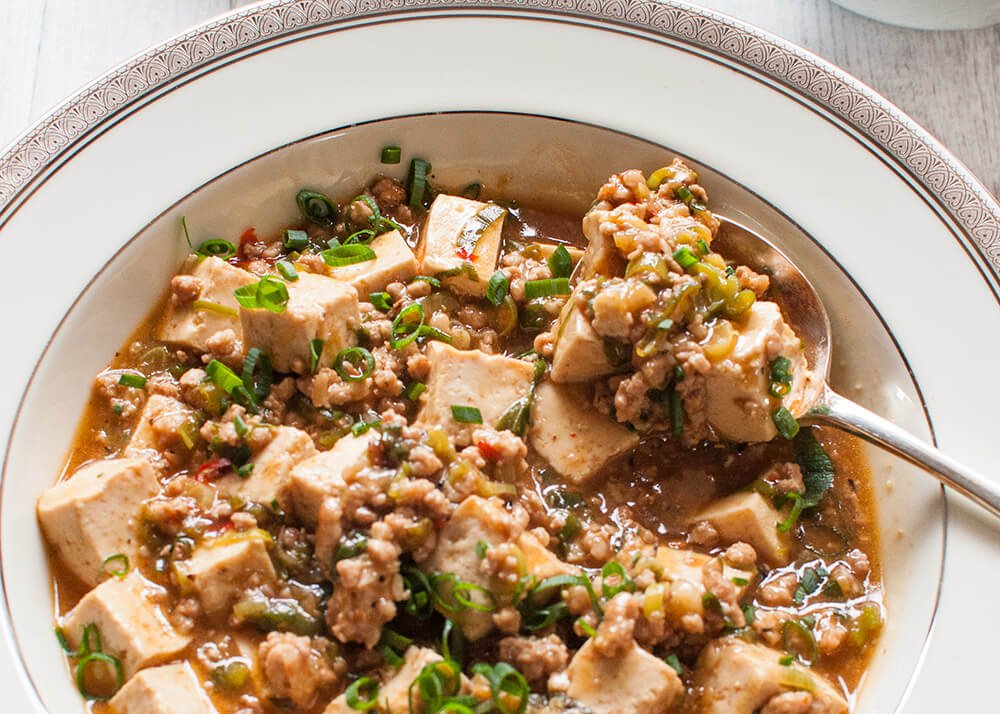
Yumiko![]()
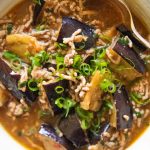
Eggplant with Minced Pork (Mābō Eggplant) is a twist on my recipe, Mābōdōfu. The fried eggplant wedges replace the tofu cubes, giving a richer flavour to the dish and a completely different texture from that of Mābōdōfu. The beautiful deep purple of the eggplant skin stimulates your appetite.
Don't forget to see the section 'MEAL IDEAS' below the recipe card! It gives you a list of dishes that I have already posted, and this recipe, so you can make up a complete meal. I hope it is of help to you.
- 350g / 0.8lb eggplant cut into bite-size wedges (note 1)
- 1½ tbsp cornflour/corn starch (note 2)
- Oil to shallow-fry eggplants
- 200g / 7.1oz pork mince/ground pork
- 1 tbsp oil
- 2 tsp garlic finely minced
- 2 tsp ginger finely minced
- 3 tbsp shallots/scallions finely sliced
- 3 tsp toban-djan (chilli bean paste)
- A pinch of salt
- 180ml / 6.1oz water (note 3)
- 2 tsp chicken stock powder (note 3)
- 1 tbsp soy sauce
- 1 tbsp sugar
- 1 tsp cooking sake
- 2 tsp brown miso
- 1 tbsp cornflour/corn starch
- Finely chopped shallots/scallions
-
Mix the Sauce ingredients well ensuring that the sugar is dissolved and there are no lumps of miso or cornflour.
-
Fill a frying pan with oil to 1cm / ⅜” deep. Heat the oil to around 170°C / 338°F.
-
While heating the oil, dust the eggplant pieces with cornflour/corn starch.
-
Gently drop the eggplant pieces into the oil (fry in batches if needed so that the oil is not overcrowded).
-
Fry for 1½ minutes until the bottom part of the eggplant pieces are slightly browned (see the photo in the post).
-
Turn them over and fry further 1 minute, then place the eggplant skin side down and fry for 30 seconds (note 4). The eggplant pieces should be slightly browned.
-
Transfer the eggplant pieces onto a tray lined with a couple of kitchen papers.
-
Heat a wok or a deep frypan over high heat. When smoke starts rising, add 1 tablespoon oil, then add pork mince.
-
Stir-fry the mince, breaking up the lumps until the mince is cooked through (about 2 minutes).
-
Add the remaining Chilli Pork Mince ingredients and stir-fry for 15-30 seconds, ensuring that all ingredients are mixed well.
-
Add all the Sauce ingredients to the mince and mix lightly. When the sauce starts thickening, add the eggplants and gently mix.
-
When the sauce starts boiling, turn the heat off. Transfer to a serving bowl, sprinkle shallots over. Serve immediately.
1. I used a large eggplant. I cut it vertically into 6 wedges, then cut them perpendicular to the first cut, into the bite-size pieces.
You can use skinny/small eggplants if you want. In this case, you may only halve or quarter them vertically depending on the thickness of the eggplants.
2. You can omit cornflour coating of the eggplant pieces if you want. But cornflour-coated eggplants are juicier and moist.
3. You can substitute with 180ml / 6.1oz of chicken broth.
4. I did cook the eggplant pieces with the skin-side down at the end because I used a large eggplant and its skin is quite hard. If you are using skinny/small eggplant, you probably needn’t do this.
5. Eggplant with Minced Pork (Mābō Eggplant) can keep a day or two in the fridge but the colour of the eggplant skin may become less vibrant.
6. Nutrition pr serving. Assumed that eggplant's oil absorption % is about 12%.
serving: 228g calories: 324kcal fat: 25g (38%) saturated fat: 4.9g (25%) trans fat: 0.1g polyunsaturated fat: 3.5g monounsaturated fat: 15g cholesterol: 36mg (12%) sodium: 424mg (18%) potassium: 437mg (12%) carbohydrates: 15g (5%) dietary fibre: 3.6g (14%) sugar: 7.3g protein: 11g vitamin a: 1% vitamin c: 5.7% calcium: 2% iron: 6%
Meal Ideas
A typical Japanese meal consists of a main dish, a couple of side dishes, a soup and rice. I try to come up with a combination of dishes with a variety of flavours, colours, textures and make-ahead dishes.
Mābō Eggplant does not contain a lot of meat for a main dish. So, I picked a Chicken Stir Fry as a side dish. This dish was posted as a main dish but you can serve it in a small bowl as a side.
Sweet and sour Pickled Chrysanthemum Radish cleanses the palate after eating the Mābō Eggplant.
- Main: Eggplant with Minced Pork (Mābō Eggplant) – today’s recipe, you can make ahead
- Side dish 1: Chicken Stir Fry with Celery, Carrot and Cashew – serve a small quantity as a side
- Side dish 2: Pickled Chrysanthemum Radish – make ahead
- Soup: Japanese Style Egg Drop Soup (Kakitama-jiru) – or other clear soup
- Rice: Cooked Rice
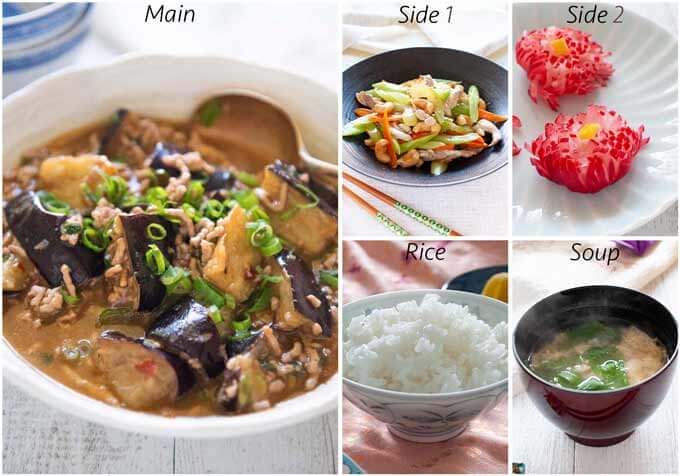
Delicious. My wife is from Sichuan and I’ve made the more traditional Mapo Dofu many times, but this variation allows our young son to enjoy it but also get some good vegetable content. You can use the same base paste as proper Mapo Dofu. Great idea I hadn’t come across before.
Hi David, I am honoured to receive a 5-star from the person who is familiar with Sichuan dishes. Thank you!
Such an easy recipe and so delicious. I can’t wait to try some of the others.
Hi Hellen, thanks! Please let me know what you think when you try other dishes.